System Operations impact of Covid-19: European perspective
According to the World Health Organisation (WHO), a viral pneumonia of unknown cause detected in Wuhan, China, was first reported to the WHO Country Office in China on December 31, 2019. On February 11, 2020, WHO announced a name for the new coronavirus disease: Covid-19, and this virus has since become a worldwide pandemic with a major socio-economic impact.
Modern societies are fully dependent on electricity, and maintaining security of supply is vital for coronavirus response and recovery. Millions of people are quarantined in their homes, many working from home, and students are following their classes on line. A fully reliable and stable Internet connection is necessary for safe shopping, connecting to office VPNs, and for school. In addition, especially in the current situation, electricity keeps hospitals and critical infrastructures running, as well as all essential home appliances.
This paper focuses on Covid-19’s impact on power system operations in the European countries with the highest number of confirmed infections; and covers – from the beginning of March 2020 - the extraordinary containment measures that were taken by EU member state governments. The goal of this paper is the description of what has been observed and which measures were taken in the power system to keep the lights on. The ‘return to normal’ plans are also addressed.
by Enrico Carlini (IT), François Boulet (FR), Jens Jacobs (DE), Jorge Hidalgo (ES), Susana Almeida de Graaff (NL)
The European power system has been operating in normal state, yet a decrease of electricity consumption load has been observed. Covid-19 extraordinary measures may not be the sole factor responsible for the decrease: weather conditions, especially solar irradiation, also played a role, boosting the electricity generation of renewable energy sources (RES) during spring.
Common aspects
- All TSOs have, as one of the main priorities, to keep their personnel safe and healthy, especially control room operators and field personnel. TSOs implemented staff separation/segregation and split teams, applied social distancing rules, intensified cleaning and disinfection, and have been using main and back-up control rooms.
- In the control room: strict staff separation (including operational planning, real-time operators, etc.) from other employees was implemented, as well as, between different shift staff in the same control room, and between staff of different control rooms, e.g. by reassigning operators, splitting teams into small clusters, organization of shifts with stable crews, and by making changes in equipment locations. The direct contact between employees has been brought to a minimum; shift change/transfers are done via phone. Control room access is limited to control room staff only; all other access, including technical personnel from back offices, has been prevented. All employees that do not work in the control room must work from home. Workspace sterilization is performed several times a day and during shift changes.
- In Italy, for each area (National Control Centre and 3 Regional Control Centres), the nearby back-up control room has been activated. Personnel alternate at each shift from the main control room to the back-up one (and vice versa), leaving the elapsed shift time to sanitize the control room not in use. This strategy also seeks to reduce contact between real time operators and minimize the risk spreading Covid-19 among them. Shift relay is conducted in a non face-to-face manner such as teleconferencing. As a ‘last resort’ containment measure, such as the case of needing three regular shifts to be quarantined, the control room staff would be segregated in dorms for 15-day periods.
- In Spain, the number of control room operators in each shift has also been reduced to a minimum, as have been all the tasks that could be performed remotely. In addition, an emergency team of former operators has been created in order to increase the control room workforce. Furthermore, a third control room has been created in the Spanish peninsula in order to back-up one of the two that normally operates in parallel.
- TSOs have their internal crisis organisations in place; crisis teams meet every day via telephone or web conference to monitor the situation and to discuss the next steps.
- In most countries, increased coordination with national authorities and other energy sector stakeholders is in place to guarantee core activities. Extraordinary daily calls have been organised with the most affected TSOs in continental Europe to exchange on forecasted situations in each country and to detect potentially critical network situations. On a suggestion by Terna, the Italian TSO, the government issued instructions to the significant national producers and DSOs to ensure they will be able to staff and operate power plants and remote distribution grid switching. This directive was followed by the establishment of a working group that includes the Ministry of Energy, grid operators, producers, and Civil Protection. A daily status report and key metrics of the Italian power system (incl. load consumption, unexpected thermal plant outages and transmission grid elements) is shared with the Ministry of Economic Development (MISE) and the National Regulator (ARERA) to ensure maximum coordination and continuous information flow.
- Many TSOs have done everything possible to ensure that control room staff and other employees are tested. Regular testing is ongoing and even required for control room staff in some countries. In Italy, infrared thermometers that measure the employees’ body temperature have been installed at the control room entrance.
- Lower than normal loads resulted in: reshaping of load curve (slope and shape) and load forecast error, high operating voltage, congestion and ancillary services, and reverse flows during the day. In addition, during periods of high voltages, several lines had to be temporarily disconnected. Generation redispatching for voltage management also been used on a few occasions:
- In Italy, we experienced high voltage values in the transmission grid due to the huge load reduction. To cope with these high voltage values, Terna adopted the following measures: operation of the reactor banks and synchronous condensers connected to the transmission grid; tap staggering procedures on internal transformers (where possible) to consume more reactive power; disconnection of unloaded power lines without violating the N-1 security criterion after verification of dynamic stability (e.g. one of unloaded double circuit power lines); procuring - on the ancillary services market - additional regulating units to achieve sufficient support for voltage regulation. These power plants are operated in under-excitation mode directly by Terna through the automatic system for secondary voltage control.
- In Spain, voltage maintenance within the required ranges has been achieved by coordinating all the resources available with the rest of the stakeholders: by coordinating and agreeing with the distribution companies’ and customers’ topological adjustments to minimize reactive power injection by customers connected to the transmission grid; on the generation side, the power factor of wind and solar facilities was changed - through the Control Centre for Renewable Energies - in order to ensure a more inductive behaviour, and additional conventional generators (gas and coal) were connected to help maintain an adequate voltage profile.
- As a consequence of less synchronous machines operating, system strength and damping capabilities were reduced in the European continental system.
- Planned outages for maintenance have been re-evaluated, postponed, or even cancelled. Most of the maintenance works have been cancelled in the generation units. The short-term impact being non-optimized generation patterns:
- In Germany, the urgent maintenance work is proceeding, but before the works start the network restoration time element is realigned with the maintenance team. In France, on the grid side, only urgent works have been maintained. The usual maintenance works are being progressively rescheduled starting from mid-May 2020.
- Italy was not concerned with power plants unavailability. Only in limited cases Italy recorded partial outages due to reduced personnel and difficulties in finding spare parts. Due to the coronavirus pandemic, non-essential outages planned during the spring period will be postponed to the second half-year, even in a period typically critical for adequacy. This will require enhanced coordination between regional TSOs to limit potential adequacy risks during winter peak periods.
- During the entire confinement period, the Spanish electrical system was almost fully available, as maintenance was reduced to a minimum to avoid exposing maintenance staff. Because of this, it is expected that more planned maintenance will occur during summer and winter due to rescheduling of maintenance works that could not have been done between March and mid-May 2020.
- Adequacy issues and the need for higher import is foreseen due to the re-scheduling of the generation units planned outages, which will have a regional impact on system operations. For instance, the lack of outage planning optimisation schedules on the generation side may lead to adequacy issues for next winter. Maintenance periods have to be respected for all units, especially nuclear ones.
- In France, EDF and RTE are working closely together on risk mitigation. The objective is to have the lowest number of units in outage during the winter months when consumption is high in France, mitigating the risk of adequacy problems.
- In France, EDF and RTE are working closely together on risk mitigation. The objective is to have the lowest number of units in outage during the winter months when consumption is high in France, mitigating the risk of adequacy problems.
- There was no impact on load frequency control. ACEs, frequency and control demand are in the normal ranges.
- Inter-TSO Coordination: Strong exchange of practices and experiences with all European TSOs via ENTSO-E.
Covid impact on demand
France
The impact of measures taken to limit the spread of Covid-19 is a decrease of the consumption by 15-20%, as shown in Figure 1. This is totally novel. For example, during the 2008-2009 economic crisis, the decrease of consumption was about 5%.
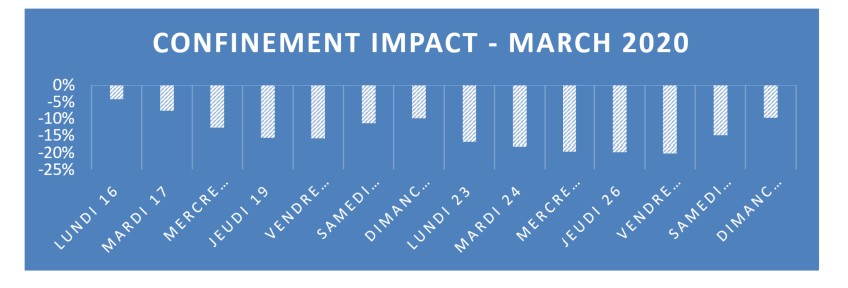
Figure 1 - Load decrease in France
The load curve shape during the day has also been very different than usual. For example, the drop in the afternoon is as deep as the drop at night. This is clearly due to the economic impact.
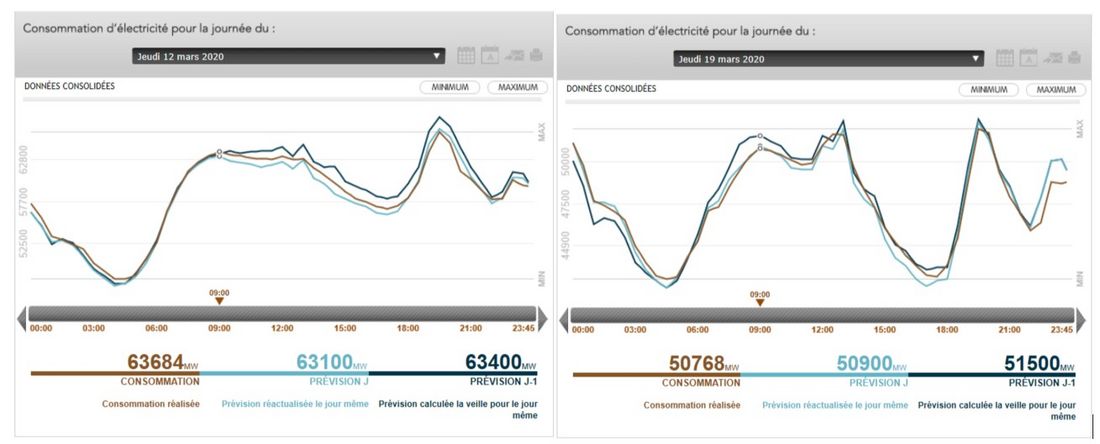
Figure 2 - Load curves with different shapes in France
Germany
The German load in March 2020 was lower than the load last year for the same period. This is a consequence of Covid-19 measures, in combination with the warm and sunny weather. Furthermore, most (if not all) manufacturing industries were stopped (e.g. automobile industry).

Figure 3 - Load profile Germany April and May 2020 in comparison to April and May 2019
In addition to all common measures mentioned above, during this period there was the need for feed-in management measures, which curtails RES production.

Figure 4 - RES infeed Germany March 2020 in comparison to March 2019
Italy
The governmental measures taken to combat the coronavirus pandemic spread have resulted in a remarkable downturn in peak electricity consumption. The decrease occurred in two stages: starting from the beginning of March 2020, with many people working from home and schools closed, the electrical demand of a normal week day fell by 10-15%. Subsequently, the Prime Minister’s lockdown announcement on March 11, 2020 caused an immediate 5-10% reduction in electrical demand and a 55% downturn of industrial loads with interruptible rates.

Figure 5 - Comparison of electricity demand before and after the lockdown
Load declined throughout the day. As shown in Figure 6, during the weekdays, on average morning peak dropped by -12.8 GW, evening peak - 8.2 GW, night valley - 4.8 GW, day valley by 6.0 GW.
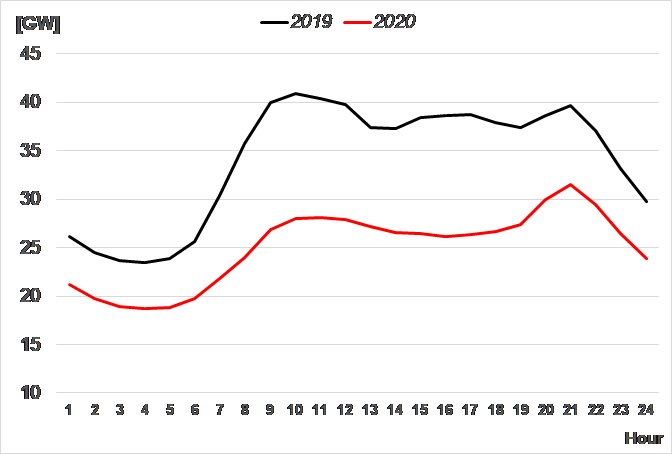
Figure 6 - hourly curves of a typical weekday of 2019 vs 2020
During extraordinary ‘low consumption’ days of the pandemic period, the southern part of Italy recorded exceptional over-generation conditions (variable RES surplus). Under these circumstances, the Italian TSO (Terna) succeeded to manage the grid in full security and faced no over-generation issues by adopting available remedial actions (e.g. strategic use of pumped storage, import reduction, deferred maintenance and outages, close coordination with neighboring TSOs, etc.). In April 2020, Italy registered a 47% average coverage of demand from RES (a record for the past 5 years), a situation that could easily happen when the yearly average goes above 55% (our 2030 target).
Spain
The application of the Covid-19 measures has had an impact on demand, in comparison with the same weeks of the previous year, showing an 8-10% decrease during the first part of the state of emergency; a decrease between 17-19% during the halt of all non-essential activities, the so called hibernation period, and a decrease between 14-18% during the second part of the state of emergency.
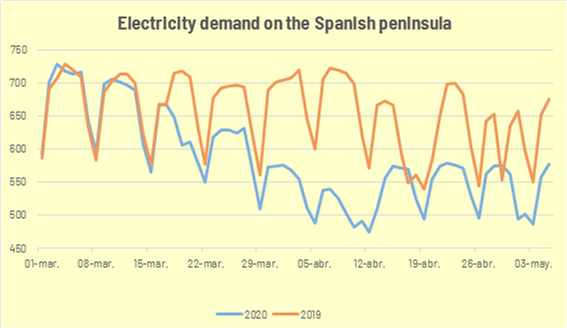
Figure 7 - Electricity demand in Spain, years 2019 and 2020
Regarding the generation portfolio, the participation of renewable energy sources in the coverage of the demand increased during this period, mainly due to a higher resource availability, hence 47% of demand was covered by renewable generation during the first three months of the year 2020, 7% higher than during the same period of 2019. Moreover, both the coverage of the demand and the capacity to balance the system was not affected and are not expected to be.
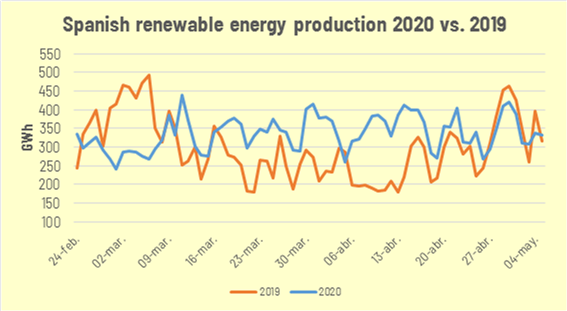
Figure 8 - Spanish renewable energy production 2020 vs. 2019
National aspects and impact
France
On March 14, 2020 the French government decided to move from stage 2 to stage 3 of the health crisis prevention plan. Restaurants, bars, cinemas, and non-essential shops were closed and people were asked to work from home. Schools were also closed.
On March 17, 2020: stay at home orders were imposed. Travel was restricted to a minimum. A printed authorization was required for any derogatory move outside of the home and limited to work, health, legal obligation, grocery shopping, and to get some fresh air or exercise (but only for a 1 hour maximum and no more than 1 km from home).
On May 11, 2020 confinement started to ease and schools started to reopen progressively; authorization is no longer required to travel in a range of 100km from home; shops can reopen, but with social distance measures. However, restaurants, bars, hotels, cinemas, and theatres remain closed. In addition, masks are mandatory on public transportation and groups are limited to a 10 people maximum. Masks and tests are readily available for public use. Along with these movement restriction measures, economic support plans have been and will continue to be taken both at national and at European level.
RTE has adapted its health crisis management plan to match the government measures. At RTE working from home remains in place for those who can do so. People are authorized to come and work on site, but building capacity is strictly limited to 33% and social distancing measures must be respected. Wearing a mask is required for all employees and grid maintenance works have been rescheduled with new safety procedures.
Germany
The German government set up an emergency task force which meets regularly. Germany has a very good disease warning and notification system, an existing pandemic preparedness plan, and regular emergency training exercises at German airports. With the aim to contain and delay further spread of the virus, Germany worked closely with international and national level authorities, constantly monitoring the public health situation. The Federal Government agreed on an extensive economic package amounting to approximately 750 billion euros to cushion the economic impact. Germany has not enforced a curfew but expressed the need to stay at home and enforced rules to only leave your home alone – or with a maximum of one person who shares the same household. People who live in the same household could go out together but were not allowed to meet other people. People are allowed outside:
- to go to work;
- to take your children to their emergency child care;
- to go grocery shopping and visit the doctor;
- to participate in meetings, necessary appointments and examinations;
- to help others; or
- to get some fresh air and do some exercise.
When possible, employees work from home. Public spaces, such as bars, cinemas, theatres, and most shops were closed (excluded: grocery stores, pharmacies, petrol stations, etc.). Also kindergarten, schools, playgrounds, gyms, and sports fields were closed.
On its ‘return to normal’, Germany introduced on April 29, 2020 a face mask requirement for everyone on public transport and while grocery shopping. On May 6, Germany announced the ease of Covid-19 lockdown restrictions along several measures (e.g. re-opening of restaurants, playgrounds, and schools, etc.) in different steps while at the same time expanding public testing for Covid-19; all under the strict fulfilment of the necessary health and safety preparations (e.g. keep at least 1,5-meter distance, always wear face protection in public, etc.). Due to the federal division of power in Germany, regional differences occur as the government sets the general Covid-19 restrictions framework and each federal state decides on how far it will enforce those measures.
Italy
At the end of February 2020, the Italian Government adopted a series of urgent measures for the contagion containment and fight against the diffusion of the Covid-19 in Italy. By the Law Decree of February 23, 2020 the Government was empowered to adopt and implement all the measures necessary to contain and manage the epidemiological emergency.
- The first step (DPCM February 23, 2020) was to establish the so-called ‘red zones’ in 11 municipalities in the North of Italy (Lombardia and Veneto Region). In these red zones, the containment measures consisted of the prohibition of leaving/access to those Municipalities, the suspension of public or private events or initiatives, school and university closures, the suspension of all commercial, work, and business activities (expect public utility and essential public services) The employers for both public and private sectors have turned to smart working for the duration of the emergency.
- The second step (DPCM March 1, 2020) was to extend restrictions to the entire Lombardy region and fourteen largely neighbouring provinces in Emilia-Romagna, Veneto, Piedmont and Marche (sixteen million people affected).
- On March 9, 2020 the government imposed a national quarantine, restricting the movement of the population except for necessity, work, and health circumstances. Additional lockdown restrictions mandated the temporary closure of non-essential activities, shops and businesses.
Specific steps adopted by the Italian TSO:
- Construction sites and maintenance activities were limited to those strictly necessary to ensure the security and continuity of supply: urgent and undelayable repairs, non-postponable maintenance, urgent cutting of vegetation, legal inspections, availability and prompt intervention, monitoring of non-interruptible construction sites, etc.
- Smart working was applied to 100% of office personnel not involved in essential activities. The following clusters of areas/activities dedicated to business continuity were excluded from smart working: Control Rooms operators, staff supporting Control Rooms’ tools and associated facilities, ICT Service Control Room, Security Operation Centre and Computer Emergency Readiness teams, Physical Safety and Security Systems, site inspection and supervision of construction sites, protection systems practitioners, and emergency staff.
- Laptop computers distribution to all employees was accelerated and measures were adopted to further strengthen Internet connectivity infrastructures, and optimisation of remote VPN (Virtual Private Network) access infrastructure.
Spain
The pandemic was confirmed to have spread to Spain on January 31, 2020 and by March 13 cases were confirmed in all provinces of the country. The state of emergency and national lockdown was ordered from March 15-30 and all non-essential workers were to stay home. On April 13 workers in some non-essential sectors, such as construction and industry, who could not work remotely, were allowed to return to work. On April 28 the government announced a four-phase plan that would remain in place at least eight weeks to ease lockdown restrictions, based on province-level public health indicators such as the number of cases and the healthcare system capacity.
The Spanish TSO business continuity plan, regarding the CODVI-19, has the health and protection of its employees and their relatives as their top priority, while also guaranteeing the electrical system security. Home office conditions have been achieved by significantly increasing the bandwidth for remote working and providing wider access to VPN services.
A new phase of the SO continuity plan has begun that is designed to protect the employees and the SO activity from an epidemic upsurge while a step-by-step approach is taken towards the return to normal activity. This includes the gradual resumption of activities in strict compliance with social distancing and health protection rules, wearing protective gear while working is required.
Market impact
Due to the consumption decreases during lockdown, prices have been historically low. Exchange patterns are not normal either because the economic impact differs based on each country’s governmental measures. Nevertheless, market mechanisms have been working quite well and the grid situation is under control.
Transfer capacity has only been minimally impacted. The main effect regarding international flow has been the lower than normal market prices. Due to a difference between countries’ varied reactions to the COVID-19 crisis, we have seen the usual energy exchanges but these have been coupled with a unusual generation schedule which has led to some equally unusual N-1 grid constraints. For example, France had faced very high South to North flows at the end of April.
What is next?
Due to the consumption decreases during lockdown, prices have been historically low. Exchange patterns are not normal either because the economic impact differs based on each country’s governmental measures. Nevertheless, market mechanisms have been working quite well and the grid situation is under control.
Transfer capacity has only been minimally impacted. The main effect regarding international flow has been the lower than normal market prices. Due to a difference between countries’ varied reactions to the COVID-19 crisis, we have seen the usual energy exchanges but these have been coupled with a unusual generation schedule which has led to some equally unusual N-1 grid constraints. For example, France had faced very high South to North flows at the end of April.
Disclaimer: This paper covers the Covid-19 situation in Europe through the end of April/beginning of May 2020.

